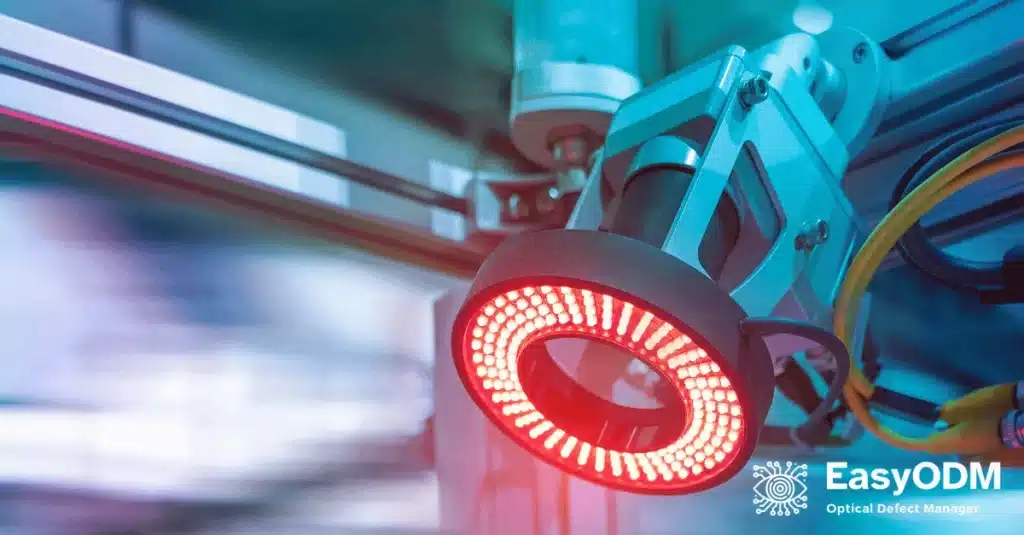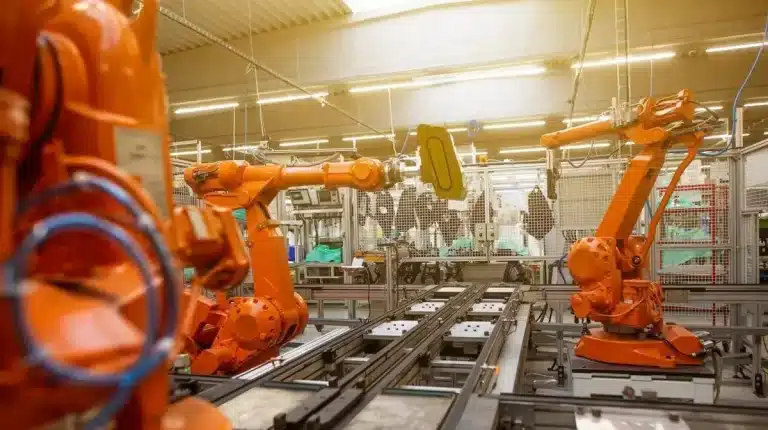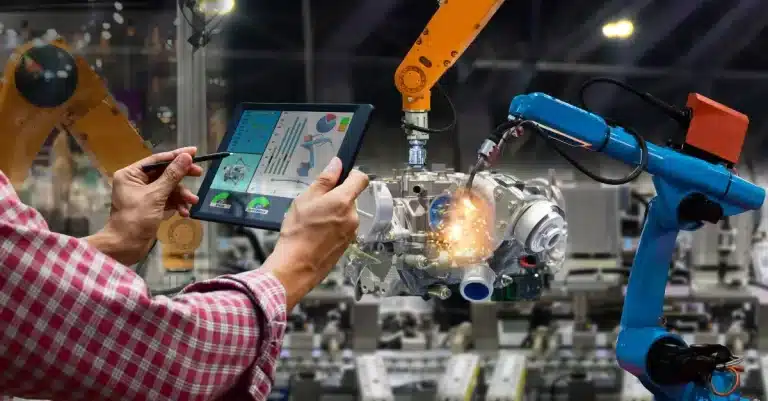Industrial cameras are becoming an indispensable tool in various machine vision applications. According Statista report the market for industrial and automation cameras is expected to grow steadily from 2020 to 2026, with robotic mobility having the highest potential for growth with a compound annual growth rate (CAGR) of 15.5% .
With their advanced technology and capabilities, these cameras are able to capture high-quality images and videos for analysis and inspection purposes. They are widely used in industries such as manufacturing, automation, robotics, and healthcare.
With the importance and wide range of applications for industrial cameras in machine vision, it’s crucial to understand the benefits they offer. So, let’s dive in and explore how these cameras can revolutionize your vision applications.
Finding the right camera for your specific needs can be overwhelming, but we’re here to guide you through the process. Let’s get started!

Key Takeaways
- Industrial cameras are essential tools for capturing and analyzing visual information in industrial applications, enabling automation of inspection processes and ensuring quality control.
- Industrial cameras play a crucial role in various industries, including automotive, electronics, pharmaceuticals, and food processing, for tasks such as object recognition, defect inspection, barcode reading, and measurement analysis.
- Key features and advancements in industrial camera technology include high-resolution image capture, advanced image processing capabilities, high-speed image capture, compatibility with different software and hardware platforms, and robust housings designed for harsh conditions.
- Benefits of using industrial cameras in machine vision applications include enhanced image quality, excellent low-light performance, robust and reliable designs, efficient and accurate image processing, and the freedom to optimize and streamline automated processes.
What is a machine vision camera?
A machine vision camera is an essential tool for capturing and analyzing visual information in industrial applications.
It allows us to automate inspection processes, improve productivity, and ensure quality control.
These cameras are specifically designed to meet the demanding requirements of industrial environments, with features such as high resolution, fast frame rates, and robust housings.
| High Resolution | Fast Frame Rates | Robust Housings |
|---|---|---|
| Allows for detailed image capture | Enables capturing of fast-moving objects | Designed to withstand harsh conditions |
| Provides accurate measurements | Reduces motion blur in high-speed applications | Protects the camera from dust, moisture, and vibrations |
| Ensures precise defect detection | Enables real-time monitoring and analysis | Increases camera lifespan |
With a machine vision camera, we can perform tasks such as object recognition, defect inspection, barcode reading, and measurement analysis.
These cameras play a crucial role in various industries, including automotive, electronics, pharmaceuticals, and food processing.
They offer the freedom to automate processes, improve efficiency, and maintain consistent product quality.
Whether it’s ensuring safety standards or enhancing production speed, machine vision cameras provide the necessary visual intelligence for successful industrial applications.

Manufacturers
There are several reputable manufacturers in the market that offer a wide range of industrial cameras for machine vision applications.
Companies such as:
- Basler
- Cognex
- IDS Imaging
- Teledyne DALSA
- Allied Vision Technologies
- Viper Imaging
- Advantech Co.,Ltd.
- Imperx, Inc.
- Teledyne FLIR LLC
- The Imaging Source
They all are known for their cutting-edge camera technology and innovative solutions.
Technologies
Machine vision cameras utilize different technologies to capture and process images. Some of the commonly used technologies include CMOS and CCD sensors.
CMOS sensors have gained popularity in recent years due to their lower power consumption and faster readout speeds compared to CCD sensors. These sensors are capable of delivering high-resolution images with excellent image quality.
Spectrum
Machine vision cameras are available in different spectrums, including monochrome and color options.
Monochrome cameras are ideal for applications where image analysis and precise measurement are critical.
On the other hand, color cameras provide additional information and are suitable for applications that require color differentiation and recognition.
Interfaces
Industrial cameras use different interfaces to connect with vision systems and other components.
Some of the commonly used interfaces include GigE Vision, USB3 Vision, and Camera Link.
GigE Vision is widely adopted due to its high data transfer rates and compatibility with Ethernet.
USB3 Vision offers fast image transfer speeds, making it suitable for high-resolution imaging applications.
Camera Link is a popular choice for high-performance industrial machine vision cameras.
Resolution levels
The resolution of the camera is a crucial factor to consider when selecting a machine vision camera for a specific application.
The resolution of an industrial camera is the number of pixels it can capture. The higher the resolution, the more detail the camera can capture. Industrial cameras typically have resolutions ranging from VGA (640 x 480 pixels) to 64 megapixels.
The resolution that you need will depend on the specific application you are using the camera for. For example, a camera used for barcode reading will need a lower resolution than a camera used for medical imaging.
Here are some of the most common resolution levels for industrial cameras:
- VGA (640 x 480 pixels)
- QVGA (320 x 240 pixels)
- 720p (1280 x 720 pixels)
- 1080p (1920 x 1080 pixels)
- 4K (3840 x 2160 pixels)
- 8K (7680 x 4320 pixels)
Some industrial cameras also offer megapixel resolutions, such as 12 megapixels, 20 megapixels, and 64 megapixels. These cameras are typically used for applications where high-detail images are required, such as medical imaging and quality control.
When choosing an industrial camera, it is important to consider the resolution that you need, as well as the other features of the camera, such as the frame rate, the sensor type, and the interface.
Here are some of the factors to consider when choosing the resolution of an industrial camera:
- The size of the object being imaged. The larger the object, the lower the resolution you can get away with.
- The distance between the camera and the object. The closer the camera is to the object, the higher the resolution you will need.
- The level of detail required. The more detail you need to capture, the higher the resolution you will need.
- The budget. Industrial cameras with higher resolutions tend to be more expensive.
Here are some of the latest trends in resolutions used in industrial cameras:
- 4K and 8K resolutions: These resolutions are becoming increasingly common in industrial cameras, as they offer a significant improvement in image detail over lower resolutions. 4K cameras have a resolution of 3840 x 2160 pixels, while 8K cameras have a resolution of 7680 x 4320 pixels. These resolutions are ideal for applications where high-detail images are required, such as medical imaging, quality control, and machine vision.
- High frame rates: High frame rates are also becoming increasingly important in industrial cameras, as they allow for capturing fast-moving objects. Frame rates of 60fps or higher are becoming common in industrial cameras, and some cameras even offer frame rates of up to 120fps or 240fps. High frame rates are ideal for applications such as motion detection, robotics, and sports videography.
- Multi-megapixel resolutions: Multi-megapixel resolutions are becoming increasingly common in industrial cameras, as they offer a significant improvement in image detail over lower resolutions. Multi-megapixel cameras have resolutions of 12 megapixels or higher, and some cameras even offer resolutions of up to 64 megapixels. These resolutions are ideal for applications where high-detail images are required, such as medical imaging, quality control, and machine vision.
- Intelligent cameras: Intelligent cameras are becoming increasingly popular in industrial applications, as they can perform complex tasks such as object identification, defect detection, and tracking without the need for external software. Intelligent cameras typically have built-in image processing algorithms and can be programmed to perform specific tasks.
- Embedded vision systems: Embedded vision systems are becoming increasingly popular in industrial applications, as they offer a complete solution for machine vision. Embedded vision systems typically consist of a camera, image processing hardware, and software, and they can be easily integrated into industrial machines and robots.
Application Case Studies
Here are sone case studies where industrial cameras have been used to address specific challenges.
- PET Preforms AI Quality Inspection: This case study exemplifies the significance of industrial cameras in quality control. EasyODM’s machine vision software, which utilizes industrial cameras, helped the PET preform manufacturer ensure consistent color quality and detect defects efficiently. It showcases how industrial cameras are crucial for accurate defect recognition and improving production standards. Read the case study.
- Computer Vision Based Fabric Quality Inspection: In the textile industry, industrial cameras are essential for fabric quality control. EasyODM’s solution, powered by AI and computer vision, optimized the inspection process, demonstrating the role of industrial cameras in enhancing efficiency. This case study highlights the synergy between industrial cameras and advanced technologies for quality checks. Read the case study.
- Automated AI Quality Control in Lamella Flooring Manufacture: Quality control in hardwood flooring production requires precision, which is facilitated by industrial cameras. EasyODM’s automated visual inspection software, driven by machine vision and AI, showcases how industrial cameras can reduce defects and enhance product quality. It underscores the importance of industrial cameras in maintaining high standards. Read the case study.
- Automotive Seats AI Defects Detection: Defect detection in automotive manufacturing demands accuracy, and industrial cameras play a crucial role. EasyODM’s use of machine learning and industrial cameras to identify defects in automotive seats illustrates their significance in ensuring top-quality products. This case study emphasizes the role of industrial cameras in the automotive industry. Read the case study.
These case studies demonstrate the versatility and effectiveness of industrial cameras in overcoming specific challenges, providing the freedom to optimize processes and achieve desired outcomes.
Frequently Asked Questions
What are the different types of industrial cameras?
Industrial cameras are used to capture images in a variety of environments and applications. The most common types of industrial cameras are area scan cameras, line scan cameras, 3D cameras, thermal cameras, hyperspectral cameras, microscopic cameras, and endoscope cameras. The best type of industrial camera for your needs will depend on the specific application you are using it for.
Which industrial camera is the best?
The best industrial camera is the one that best meets your specific needs. There is no single “best” camera for all applications. The factors you need to consider when choosing an industrial camera include:
1) The type of image you need to capture (2D, 3D, thermal, hyperspectral, etc.)
2) The resolution and frame rate required
3) The working environment (temperature, humidity, vibration, etc.)
4) The budget
How Do Industrial Cameras for Machine Vision Differ From Regular Consumer Cameras?
They are designed for specific industrial applications, such as inspection and quality control, and have higher resolutions, faster frame rates, and advanced image processing capabilities.
What Are Some Common Challenges Faced When Using Industrial Cameras in Machine Vision Applications?
Some common challenges we face when using industrial cameras in machine vision applications are ensuring compatibility with different software and hardware systems, dealing with high data volumes, and ensuring accurate and reliable image processing.
Are There Any Specific Certifications or Standards That Industrial Cameras for Machine Vision Applications Need to Meet?
Yes, there are specific certifications and standards that industrial cameras for machine vision applications need to meet. These ensure the cameras meet quality and performance requirements, allowing for reliable and accurate image capture in various industrial settings.
Conclusion
In conclusion, industrial cameras play a crucial role in machine vision applications, offering advanced features and benefits. These cameras enable precise image capture, analysis, and interpretation, facilitating automation and quality control processes.
With a wide range of options available, finding the right camera for your specific application is essential. From inspecting products on assembly lines to monitoring traffic flow, industrial cameras provide valuable insights that help improve efficiency and accuracy.

